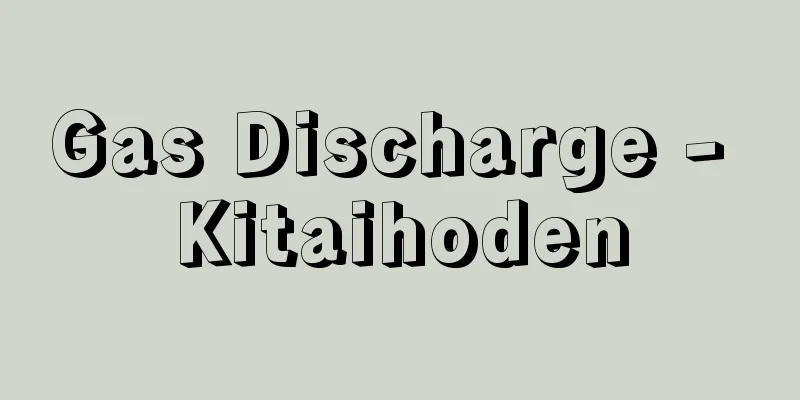Gas Discharge - Kitaihoden

|
Discharge in gas. This is the most common type of discharge. Gas is normally an insulator that barely conducts electricity, but when a voltage is applied between two electrodes placed in the gas and the voltage is increased, at a certain voltage value, the current between the electrodes increases suddenly and a spark is emitted. The voltage at which this current increases suddenly is called the discharge inception voltage or spark voltage. Discharge in gas is classified into glow discharge, arc discharge, corona discharge, spark discharge, dielectric barrier discharge, and electrodeless discharge depending on the appearance of the light-emitting part and the operation of the electrodes. Also, depending on the gas pressure, discharge in gas at about 1 atmosphere or more is classified as high-pressure discharge, and discharge at a lower pressure of less than 1 atmosphere is classified as low-pressure discharge. [Tadatoshi Azuma] Discharge starting mechanismWhen a voltage is applied between two electrodes, a cathode and an anode, in the gas, a small amount of negative and positive ions present in the gas move between the electrodes due to ionization caused by natural radiation such as cosmic rays, and a small current flows (at this stage, the discharge has not yet started). When the voltage is further increased, these ions, especially the negative ion electrons, are accelerated and ionize gas molecules and atoms to create positive ions and free electrons. When these electrons further ionize other gas molecules and atoms, the electrons increase in number like an avalanche and flow toward the anode. Meanwhile, the positive ions, which are created in the same number as the electrons, flow toward the cathode and collide with the cathode, knocking an electron out of the cathode with a certain probability. In this way, the discharge is maintained. The conditions under which N positive ions created from one electron released from the cathode can again release one electron from the cathode are called the discharge self-sustaining conditions or discharge initiation conditions. If more than one electron is knocked out of the cathode, the current increases over time. Under conditions where the current increases over time, the discharge device will be destroyed if the current is not appropriately limited by something like a resistor. In the case of a discharge lamp, the circuit component that limits the current is called a ballast. The ionization of gas molecules and atoms by accelerated electrons is called alpha action, and the expulsion of electrons from the cathode by positive ions is called gamma action. [Tadatoshi Azuma] Current-Voltage CharacteristicsLet's measure the voltage between the electrodes while gradually increasing the current by suppressing a sudden increase in current using an external circuit. First, when a voltage is applied between the electrodes, a small current flows due to the small amount of ions present in the gas. If the voltage is further increased, ionization begins to occur due to collisions of electrons at a certain voltage, and the current increases. When the current value becomes large enough, the density of positive ions in front of the cathode becomes very high. As a result, the electric field in front of the cathode becomes very strong, and ionization is effectively performed, so the electric field in other parts becomes weaker, and the overall voltage between the electrodes becomes lower. This increase in the positive ion density in front of the cathode and the increase in the electric field are called the charge accumulation effect, and discharges in this state are called glow discharges. In the current range of glow discharges, the light emission (glow) of the gas becomes noticeable. The range of glow discharges in which the voltage between the electrodes hardly changes even when the current is changed is called normal glow discharge. In this range, the change in current corresponds to the change in the discharge area on the cathode surface. If the discharge area covers the front of the cathode, it is necessary to increase the voltage between the electrodes to increase the current further. This region is called abnormal glow discharge. In an abnormal glow discharge, the cathode temperature begins to rise, and when it reaches a certain temperature, thermionic emission begins, and as the current increases, the electrode temperature rises further, thermionic emission increases, the voltage drop in front of the cathode decreases, and the voltage between the electrodes also decreases. A discharge in which the supply of electrons from the cathode is achieved by thermionic emission is called an arc discharge, and this change is called the transition from glow discharge to arc discharge. In the arc discharge region, the voltage does not change much as the current increases. Of the above discharge processes, the glow discharge region and the arc discharge region, in which the voltage between the electrodes does not change much even if the current changes, are often used in practical devices. For example, glow discharge is used in neon signs, neon tubes, starter tubes, and constant-voltage discharge tubes, while arc discharge is used in lighting sources such as fluorescent lamps, mercury lamps, low- and high-pressure sodium lamps, metal halide lamps, xenon lamps, and arc lamps. [Tadatoshi Azuma] Other gas dischargesSpark discharge generally refers to a discharge accompanied by a flash of light and sound, and is also called a spark. A typical example is lightning. Corona discharge is a partial discharge that can be seen at the tip of a needle electrode. Dielectric barrier discharge is a discharge caused by applying an AC voltage to a gas via a dielectric, which is an insulator. Electrodeless discharge is a discharge caused by passing an AC current around a discharge tube that has no electrodes. [Tadatoshi Azuma] "Ionized Gases" by Engel, translated by Kenzo Yamamoto and Takayoshi Okuda (1968, Corona Publishing)" ▽ "Discharge Handbook" edited by the Institute of Electrical Engineers (1978, Ohmsha)" ▽ "Fundamentals of Gas Discharges" by Susumu Takeda, revised edition (1990, Tokyo Denki University Press)" [References] | | | | | |©Shogakukan "> Typical current-voltage characteristics of a gas discharge Source: Shogakukan Encyclopedia Nipponica About Encyclopedia Nipponica Information | Legend |
|
気体中における放電。放電のもっとも一般的なものである。気体は普通は電気をほとんど通さない絶縁物であるが、気体中に置いた二つの電極の間に電圧をかけ、電圧を増大していくと、ある電圧値において電極間の電流が急激に増加し、同時に火花を発する。この電流が急増する電圧を放電開始電圧または火花電圧という。気体中の放電では、発光部の外観や電極の動作などにより、グロー放電、アーク放電、コロナ放電、火花放電、誘電体バリア放電、無電極放電に分類される。また気体の圧力により、約1気圧以上の気体中における放電を高圧放電、それより低い数分の1気圧以下での放電を低圧放電と分類することもある。 [東 忠利] 放電開始機構気体中の陰極と陽極の二つの電極の間に電圧を加えていくと、初め宇宙線のような自然放射線などの電離により、気体中にわずかに存在する陰イオンおよび陽イオンが電極間を移動して、微小な電流が流れる(この状態では、放電はまだ始まっていない)。さらに電圧を増加すると、これらのイオン、とくに陰イオンである電子が加速され、気体分子や原子を電離して陽イオンと自由な電子をつくる。この電子がさらに他の気体分子や原子を電離すると、電子は雪崩(なだれ)状に増加して陽極に向かって流れる。一方、電子と同数つくられる陽イオンは、陰極に向かって流れ、陰極に衝突して、ある確率で陰極から電子をたたき出す。このようにして放電が維持される。陰極から出た1個の電子がもとになって生じたN個の陽イオンがふたたび陰極から1個の電子を出させるような条件を、放電自続条件または放電開始条件という。1個よりも多い電子が陰極からたたき出されるならば、電流は時間とともに増大する。電流が時間とともに増大する条件では、抵抗体のようなもので電流を適当に制限しないと、放電装置を壊すことになる。放電ランプの場合では、電流を制限する回路部品を安定器という。また加速された電子が気体分子や原子を電離することをα作用(アルファさよう)といい、陽イオンが陰極から電子をたたき出すことをγ作用(ガンマさよう)という。 [東 忠利] 電流電圧特性外部回路により電流の急増を抑制し、電流を徐々に増加させながら電極間の電圧を測定してみよう。まず電極間に電圧を加えると、気体中にわずかに存在するイオンのため、微小電流が流れる。さらに電圧を増加すると、ある電圧付近から電子の衝突により、電離が行われるようになり、電流が増加する。ある程度電流値が大きくなると、陰極前面の陽イオンの密度が非常に高くなる。それに伴って、陰極前面の電界が非常に強くなり、電離が効果的に行われるようになるため、他の部分の電界は逆に弱くなり、全体として電極間の電圧は低くなる。このように陰極前面の陽イオン密度が高くなって電界が強くなることを電荷の蓄積効果といい、このような状態での放電をグロー放電という。グロー放電の電流域では気体の発光(グロー)が顕著となる。グロー放電のうち、電流を変化させても電極間の電圧がほとんど変化しない範囲を正規グロー放電という。この範囲では、電流の変化が陰極面での放電面積の変化に対応している。放電面積が陰極の前面を覆ってしまうと、さらに電流を増加するためには、電極間の電圧を増加する必要がある。この領域を異常グロー放電という。異常グロー放電では、陰極温度が上昇を始め、ある温度以上になると、熱電子放出が始まり、電流の増大とともに電極温度がさらに上昇し、熱電子放出が増加して、陰極前面の電圧降下が減少し、電極間の電圧も低下する。陰極からの電子の供給が、熱電子放出により行われている放電をアーク放電といい、この変化を、グロー放電からアーク放電への移行という。アーク放電領域では、電流の増加に対し電圧はあまり変化しない。 以上の放電過程のうち、電流が変化しても電極間の電圧があまり変化しないグロー放電域とアーク放電域の二つが実用装置によく利用される。たとえばグロー放電を利用したものにはネオンサイン、ネオン管、点灯管、定電圧放電管があり、アーク放電を利用したものには蛍光ランプ、水銀ランプ、低圧および高圧のナトリウムランプ、メタルハライドランプ、キセノンランプ、アーク灯などの照明用の光源がある。 [東 忠利] そのほかの気体放電火花放電は一般に閃光(せんこう)と音を伴う放電をいい、スパークともいう。その代表的なものに雷がある。コロナ放電は針状電極の先端などにみられる部分放電をいう。誘電体バリア放電は絶縁体である誘電体を介して気体に交流電圧をかけておこす放電をいう。無電極放電は電極をもたない放電管の周囲に交流電流を流すことによりおきる放電をいう。 [東 忠利] 『エンゲル著、山本賢三・奥田孝美訳『電離気体』(1968・コロナ社)』▽『電気学会編『放電ハンドブック』(1978・オーム社)』▽『武田進著『気体放電の基礎』新訂版(1990・東京電機大学出版局)』 [参照項目] | | | | | |©Shogakukan"> 気体放電の典型的な電流電圧特性 出典 小学館 日本大百科全書(ニッポニカ)日本大百科全書(ニッポニカ)について 情報 | 凡例 |
<<: Aircraft insurance - Kitaihoken
>>: Gas fugitive method - Kitai fugitive method
Recommend
Large butterfly fly - Large butterfly fly
...Adults can often be seen spinning around on gl...
Lifesaving equipment - Kyuumeikigu
...A general term for instruments and equipment u...
Ageuta - Ageuta
One of the names of musical components of Heikyoku...
Ansei Provisional Treaty
→ Ansei Five-Nation Treaty Source : Heibonsha Ency...
Oikawa - Oikawa
A freshwater fish belonging to the order Cyprinif...
Larvikite
…Black granite has an extremely small coefficient...
Weak point - Vital point
〘noun〙① A vital part of the body where attack can ...
Astrolabe (English spelling)
A celestial altitude measuring device developed by...
Fire chief
〘Noun〙① In the ancient military system, the leader...
Fujiwara Booklet - Tsuzurabumi
A collection of poems and prose. Six volumes and s...
laïki mousikí (English notation) laikimousiki
...Today's traditional Greek music is charact...
Praga, M. (English spelling) PragaM
…From about 1880 he turned to tragedy, but he exc...
Squid fishing - Ikatsuri
…A type of lure used for squid fishing. A cylindr...
Kokand (English spelling) Kokand
A city in Fergana Province, Republic of Uzbekista...
Diary of the Imperial Court
This is a duty diary kept by the kurōdo serving in...









